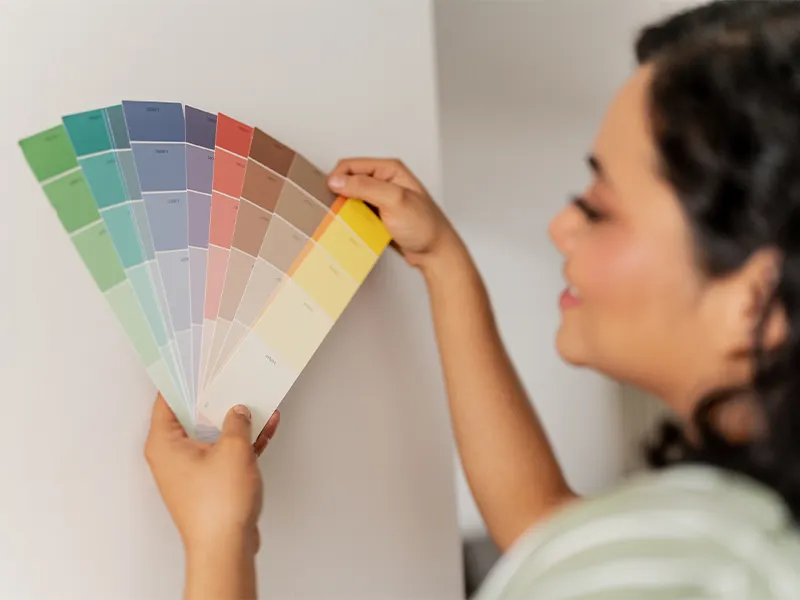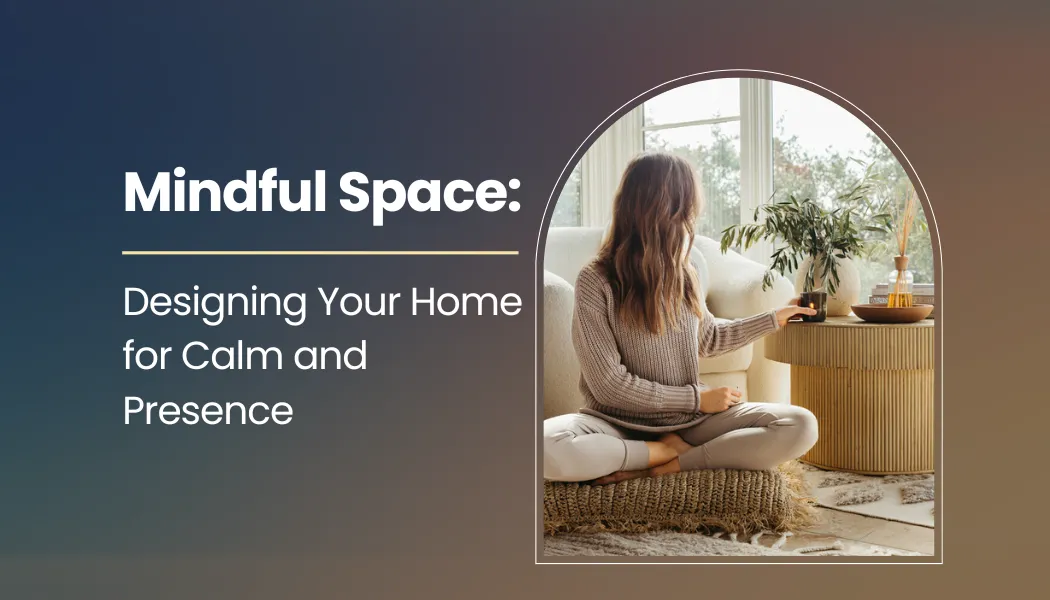In today’s fast-paced, overstimulated world, many of us find our homes becoming just another extension of the chaos we experience outside. We wake up to clutter, rush through messy kitchens, and collapse in bedrooms filled with distractions. But what if our homes could serve a different purpose—not just as shelters but as sanctuaries? What if every corner, color, and object in our space helped us return to ourselves, slow down, and live with presence?
This is where the idea of mindful space comes in. Designing your home with mindfulness doesn’t necessarily mean adopting a minimalist or aesthetic trend. Instead, it’s about intentionally shaping your environment so that it supports calm, focus, and awareness. The way we arrange furniture, choose colors, and declutter rooms affects not only the way our homes look, but how we feel inside them.
This article explores how you can create a mindful home environment—one that encourages calmness, nourishes mental health, and strengthens your sense of presence in daily life. From decluttering and lighting to choosing meaningful objects and designing mindful corners, we’ll dive into practical and inspiring ways to turn your home into a place of peace.
Table of contents
- The Connection Between Space and State of Mind
- Principles of Mindful Design
- Step 1: Declutter With Awareness
- Step 2: Invite Natural Light
- Step 3: Choose Colors Consciously
- Step 4: Furniture With Flow and Function
- Step 5: Bring Nature Indoors
- Step 6: Create Mindful Corners
- Step 7: Sound and Scent
- Step 8: Ritualize Everyday Spaces
- Mindful Space and Relationships
- The Broader Impact: Community and Sustainability
- The Ongoing Journey
- Conclusion: Home as a Reflection of Inner Peace
The Connection Between Space and State of Mind
Before diving into design, let’s understand why environment matters so much. Research in psychology and neuroscience shows that our surroundings have a direct influence on mood, focus, and stress levels.
- Clutter creates cognitive overload. A disorganized room competes for your attention, increasing stress and reducing productivity.
- Lighting affects circadian rhythms. Harsh artificial lights at night can disrupt sleep, while natural light in the day improves mood and energy.
- Colors influence emotions. Soft blues and greens soothe the nervous system, while bright reds and oranges stimulate energy.
- Objects carry emotional weight. The items around us often represent memories, values, or even unresolved emotions.
Mindful design isn’t about perfection—it’s about alignment. When your environment aligns with your values, it reinforces your sense of calm and presence.
Principles of Mindful Design
To create a mindful space, keep these guiding principles in mind:
- Simplicity: A calm space is one free of excess. This doesn’t mean stark minimalism but curating with intention.
- Presence: Design choices should encourage being in the moment—whether that’s a meditation corner or simply a dining table without phones.
- Nature Connection: Biophilic design—bringing elements of nature indoors—has proven effects on reducing stress and enhancing well-being.
- Personal Meaning: Every item in your space should have a story, a function, or a purpose.
- Balance: Mindfulness thrives in balance—between light and dark, empty and filled, soft and hard textures.
Step 1: Declutter With Awareness
Decluttering is often the first step in mindful home design. But rather than seeing it as a chore, treat it as a meditative practice.
- Start small: Begin with a drawer or a shelf, rather than tackling the whole house at once.
- Ask mindful questions: Does this object serve me? Does it spark joy, peace, or usefulness? Or does it bring guilt, stress, or clutter?
- Practice gratitude: Before donating or discarding items, take a moment to thank them for their role in your life.
Decluttering isn’t about creating emptiness—it’s about creating space for presence. A clear room is like a clear mind.
Step 2: Invite Natural Light
Lighting is one of the most powerful tools for designing a mindful home.
- Maximize daylight: Keep windows unobstructed, use light curtains, and arrange furniture to make the most of natural light.
- Layered lighting: In the evenings, switch to softer, warmer lamps instead of harsh overhead lights.
- Candlelight rituals: Lighting a candle can transform a room into a meditative sanctuary, signaling your body to slow down.
Natural light connects us with the rhythms of the day, reminding us to live in tune with the present moment.
Step 3: Choose Colors Consciously
Colors shape the mood of a space, so choose with mindfulness:
- Blues and greens: Calming, reminiscent of water and nature. Perfect for bedrooms or meditation areas.
- Neutrals and earth tones: Grounding and versatile, they create stability.
- Soft yellows and warm whites: Uplifting, especially in kitchens or workspaces.
- Minimal accents: Use brighter colors sparingly, as accents rather than dominating tones.

Instead of following trends, ask yourself: How do I want to feel in this room? Then choose accordingly.
Step 4: Furniture With Flow and Function
Mindful design is not about filling every corner with furniture but about allowing flow and ease.
- Prioritize comfort: Invest in furniture that supports the body—ergonomic chairs, supportive sofas, beds that truly rest you.
- Create space to breathe: Avoid overcrowding rooms; allow walking space and openness.
- Encourage social connection: Arrange seating in a way that invites conversation and presence, not just TV-watching.
- Mindful eating: Keep your dining area simple, inviting meals without distractions.
Step 5: Bring Nature Indoors
Humans thrive when connected to nature, even inside their homes.
- Plants: Add greenery to purify air and create calm. Snake plants, peace lilies, and succulents are easy starters.
- Natural materials: Use wood, stone, clay, or bamboo to ground your space.
- Water elements: A small tabletop fountain can bring the soothing sound of flowing water.
- Views: If possible, position seating where you can look outside at trees, sky, or gardens.
Nature doesn’t just decorate—it heals.
Step 6: Create Mindful Corners
Sometimes, mindfulness needs a dedicated space. Even if your home is small, carve out a mindful corner:
- Meditation nook: A cushion, a soft rug, and maybe a candle or small altar.
- Reading chair: A cozy corner with a lamp and blanket, free from screens.
- Gratitude wall: A space where you pin notes, affirmations, or photos that remind you of joy.
- Digital detox zone: A room or area where phones and devices are not allowed.
These corners act as anchors, reminding you to pause and return to presence.
Step 7: Sound and Scent
Mindful design isn’t only about what you see—it’s also about what you hear and smell.
- Sound: Add calming music, chimes, or white noise to drown out stress. Avoid constant TV noise.
- Scent: Essential oils like lavender, sandalwood, or citrus can create calm or uplift energy.
- Silence: Sometimes the most mindful soundscape is simply the absence of noise.
By engaging the senses, you make your home an immersive sanctuary.
Step 8: Ritualize Everyday Spaces
Mindfulness is about turning the ordinary into the extraordinary. Consider:
- Kitchen as nourishment temple: Keep counters clear, display fresh produce, and create rituals around brewing tea or cooking.
- Bathroom as spa: Add plants, natural soaps, and soft lighting to turn hygiene into self-care.
- Bedroom as sanctuary: Keep tech away, invest in soft bedding, and use calming colors for deep rest.
Every room can carry its own mindful ritual.
Mindful Space and Relationships
Our homes don’t just affect us individually—they shape the way we connect with others. A mindful space:
- Encourages deeper conversations (when phones aren’t on the dinner table).
- Strengthens bonds (when seating invites connection).
- Reduces stress-based conflicts (when clutter and chaos are minimized).
Mindful design is not only self-care; it’s relationship care.
The Broader Impact: Community and Sustainability
Designing with mindfulness can also align with sustainability and community values.
- Choose sustainable materials to reduce environmental impact.
- Support local artisans for meaningful décor.
- Reuse and repurpose instead of buying excessively.
- Share your home by creating welcoming spaces for gatherings, workshops, or community circles.
When our homes reflect mindful choices, they ripple outward to the planet and community.
The Ongoing Journey
Creating a mindful home is not a one-time project—it’s an ongoing practice. As life changes, so will your space. New jobs, children, losses, and moves will all shift what your sanctuary looks like. The key is to continually ask:
- Does this space support my calm?
- Does it reflect what I value right now?
- Does it encourage presence in my daily routines?
With these questions, your home evolves alongside you.
Conclusion: Home as a Reflection of Inner Peace
A mindful home doesn’t have to be perfect. It doesn’t require expensive furniture, trendy aesthetics, or magazine-worthy interiors. Instead, it requires intention—the choice to shape your environment so it supports who you are and how you want to live.
When you walk into a mindful space, you feel it immediately. The air feels lighter, the noise softer, the colors calmer. It invites you to take a breath, slow down, and remember that life is not something to rush through but something to savor.
By designing your home with presence, you are not only creating a sanctuary for yourself but also modeling mindfulness for family, friends, and guests. In the end, your home becomes more than walls and furniture—it becomes a living practice of calm and presence.
